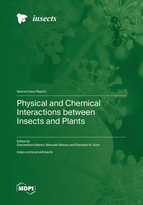Physical and Chemical Interactions between Insects and Plants
A special issue of Insects (ISSN 2075-4450). This special issue belongs to the section "Insect Pest and Vector Management".
Deadline for manuscript submissions: closed (31 December 2022) | Viewed by 26991
Special Issue Editors
Interests: insect–plant mechanical and chemical interactions; indirect plant defences; constitutive or induced by herbivores; insect electrophysiology; behaviour and chemical ecology of egg-parasitoid; morpho-functional adaptations of insects
Interests: functional morphology of insect attachment devices; insect-plant interactions; insect sensilla; functional morphology of aquatic insects
Interests: biological attachment; functional morphology; biomechanics; biotribology; biomimetics
Special Issues, Collections and Topics in MDPI journals
Special Issue Information
Dear Colleagues,
Plants and herbivorous insects, as well as their natural enemies, such as predatory and parasitoid insects, are united by intricate relationships. During the long period of co-evolution with insects, plants developed a wide diversity of features to defense against herbivores and to attract pollinators and herbivore natural enemies. The chemical basis of insect-plant interactions is established and many examples are studied, where feeding and oviposition site selection of phytophagous insects are dependent on plant secondary chemistry. Additionally, insect endosymbionts play an important role in the chemical perception, nutrition, metabolism, as well as reproduction of their host, which together determine its survival and fitness on the plant.
However, often overlooked mechanical interactions between insects and plants can be rather crucial. In this context, the evolution of plant surfaces and insect adhesive pads is an interesting example of competition between insect attachment systems and plant anti-attachment surfaces. To achieve sufficient attachment to enable locomotion on widely diverse plant surfaces, insects evolved various types of leg attachment devices enabling them to overcome plant physical defence such as cuticular microfolds, various kinds of trichomes and cristalline wax covered surfaces. Also insect mouthpart mechanics is adapted to certain mechanical properties of the plant surface, which in combination may determine insect-plant interactions.
This Special Issue will focus on the chemical and physical interactions between insects and plants, in order to understand the functional significance of plant chemistry, plant surface structures and their relationships with broad range variety of ecological groups of insects, including pollinators, herbivores and parasitoids. Contributions to all aspects of direct insect–plant interactions and as a multilayered relationship with various micro- and macro-organisms associated either temporally or spatially are welcomed.
Prof. Gianandrea Salerno
Prof. Manuela Rebora
Prof. Stanislav Gorb
Guest Editors
Manuscript Submission Information
Manuscripts should be submitted online at www.mdpi.com by registering and logging in to this website. Once you are registered, click here to go to the submission form. Manuscripts can be submitted until the deadline. All submissions that pass pre-check are peer-reviewed. Accepted papers will be published continuously in the journal (as soon as accepted) and will be listed together on the special issue website. Research articles, review articles as well as short communications are invited. For planned papers, a title and short abstract (about 100 words) can be sent to the Editorial Office for announcement on this website.
Submitted manuscripts should not have been published previously, nor be under consideration for publication elsewhere (except conference proceedings papers). All manuscripts are thoroughly refereed through a single-blind peer-review process. A guide for authors and other relevant information for submission of manuscripts is available on the Instructions for Authors page. Insects is an international peer-reviewed open access monthly journal published by MDPI.
Please visit the Instructions for Authors page before submitting a manuscript. The Article Processing Charge (APC) for publication in this open access journal is 2600 CHF (Swiss Francs). Submitted papers should be well formatted and use good English. Authors may use MDPI's English editing service prior to publication or during author revisions.









